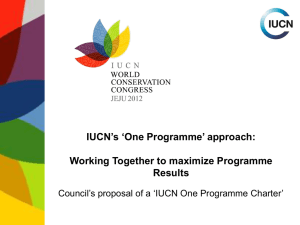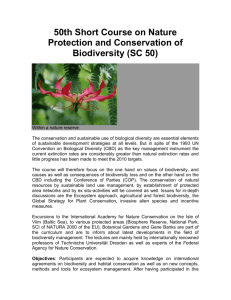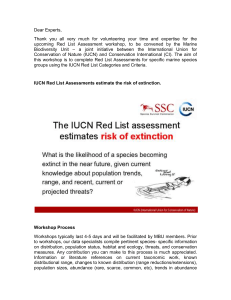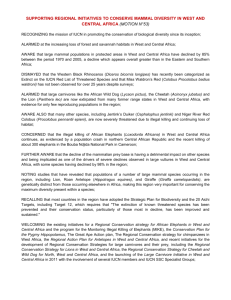CBD Global Strategy for Plant Conservation
advertisement
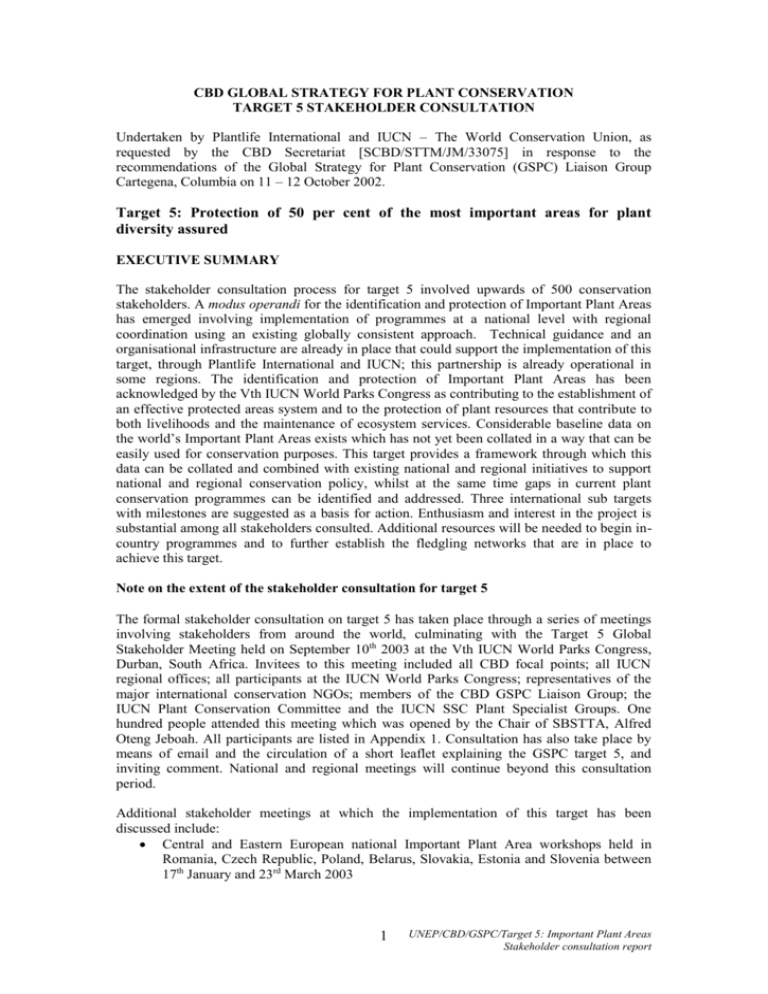
CBD GLOBAL STRATEGY FOR PLANT CONSERVATION TARGET 5 STAKEHOLDER CONSULTATION Undertaken by Plantlife International and IUCN – The World Conservation Union, as requested by the CBD Secretariat [SCBD/STTM/JM/33075] in response to the recommendations of the Global Strategy for Plant Conservation (GSPC) Liaison Group Cartegena, Columbia on 11 – 12 October 2002. Target 5: Protection of 50 per cent of the most important areas for plant diversity assured EXECUTIVE SUMMARY The stakeholder consultation process for target 5 involved upwards of 500 conservation stakeholders. A modus operandi for the identification and protection of Important Plant Areas has emerged involving implementation of programmes at a national level with regional coordination using an existing globally consistent approach. Technical guidance and an organisational infrastructure are already in place that could support the implementation of this target, through Plantlife International and IUCN; this partnership is already operational in some regions. The identification and protection of Important Plant Areas has been acknowledged by the Vth IUCN World Parks Congress as contributing to the establishment of an effective protected areas system and to the protection of plant resources that contribute to both livelihoods and the maintenance of ecosystem services. Considerable baseline data on the world’s Important Plant Areas exists which has not yet been collated in a way that can be easily used for conservation purposes. This target provides a framework through which this data can be collated and combined with existing national and regional initiatives to support national and regional conservation policy, whilst at the same time gaps in current plant conservation programmes can be identified and addressed. Three international sub targets with milestones are suggested as a basis for action. Enthusiasm and interest in the project is substantial among all stakeholders consulted. Additional resources will be needed to begin incountry programmes and to further establish the fledgling networks that are in place to achieve this target. Note on the extent of the stakeholder consultation for target 5 The formal stakeholder consultation on target 5 has taken place through a series of meetings involving stakeholders from around the world, culminating with the Target 5 Global Stakeholder Meeting held on September 10th 2003 at the Vth IUCN World Parks Congress, Durban, South Africa. Invitees to this meeting included all CBD focal points; all IUCN regional offices; all participants at the IUCN World Parks Congress; representatives of the major international conservation NGOs; members of the CBD GSPC Liaison Group; the IUCN Plant Conservation Committee and the IUCN SSC Plant Specialist Groups. One hundred people attended this meeting which was opened by the Chair of SBSTTA, Alfred Oteng Jeboah. All participants are listed in Appendix 1. Consultation has also take place by means of email and the circulation of a short leaflet explaining the GSPC target 5, and inviting comment. National and regional meetings will continue beyond this consultation period. Additional stakeholder meetings at which the implementation of this target has been discussed include: Central and Eastern European national Important Plant Area workshops held in Romania, Czech Republic, Poland, Belarus, Slovakia, Estonia and Slovenia between 17th January and 23rd March 2003 1 UNEP/CBD/GSPC/Target 5: Important Plant Areas Stakeholder consultation report South Eastern Europe preliminary Important Plant Areas meeting, Bulgaria, July 2002 Planta Europa Steering Committee meeting Bratislava, Slovakia 25 May 2003 Global Strategy for Plant Conservation and Important Plant Areas Workshop, Wellington, New Zealand convened by John Sawyer of the Department of Conservation, N.Z. Joint IUCN and Plantlife International Mediterranean workshop, IUCN Centre for Mediterranean Cooperation, Malaga, Spain 28-29 June 2003 IUCN Plant Conservation Committee workshop discussion, Durban, South Africa, 7 Sept 2003 Plenary presentation and discussion – ‘Building comprehensive protected area systems’ Vth IUCN World Parks Congress, Durban, South Africa, 12 Sept 2003 Forthcoming meetings include: Regional Important Plant Areas workshop for Central and Eastern Europe partners and CBD Focal points, 14-15 November 2003 Important Plant Areas workshop in the Philippines, November 2003 Global Strategy for Plant Conservation meeting, to be convened by SABONET (South African Botanic Garden Network), November 2003, South Africa INTRODUCTION 1. Plants are the basis for life on earth. They are primary producers and providers of ecosystem infrastructure products and services. Target 5 of the CBD Global Strategy aims to address the loss of plant diversity by ensuring the conservation of the most important areas for wild plant diversity (not just ‘hotspots’), through identifying and protecting a network of the best sites for plant conservation in all parts of the world using globally consistent criteria. 2. In many countries, particularly developing countries, many of the poorest people rely on wild plants for countless useful products and services. By ensuring the protection and appropriate management of the best sites for plant diversity, the plant products derived from them will also be conserved, thus contributing to the maintenance of the livelihoods all over the globe. 3. The Vth IUCN World Parks Congress in Durban, South Africa, September 2003 included a comprehensive gap analysis of protected areas and highlighted the fact that despite the increase in protected area coverage worldwide, there remain significant gaps in representivity of world biodiversity in these areas. These gaps include plant biodiversity. The Congress proposed a solution to this, combining all the Important Areas initiatives: plants, birds, mammals, herptiles and fish: the Key Biodiversity Areas approach. This approach is being expounded and developed by leading international NGOs. Further information on Key Biodiversity Areas will be submitted to SBSTTA-9 and COP-7. 4. Protected Areas are a substantive agenda item for SBSTTA-9 and COP-7. The identification of Important Plant Areas through target 5 will contribute directly to the establishment of a representative and effectively managed protected areas system crucial to achieving the objectives of the Convention on Biological Diversity, including the World Summit on Sustainable Development target to reduce the loss of world biodiversity by 2010. 2 UNEP/CBD/GSPC/Target 5: Important Plant Areas Stakeholder consultation report PART 1: Clarification of activities and scope of the project; applying the ecosystem approach 5. Target 5 addresses the identification and protection of a network of the most important sites for wild plants, known as Important Plant Areas (IPAs). These sites include vascular plants, and, where data is obtainable, the so-called ‘lower plants’ (bryophytes and lichens) and fungi. 6. Important Plant Areas should be identified and protected at a national level, with regional coordination using a globally consistent approach. 7. Globally applicable criteria for the identification of Important Plant Areas have already been developed, based on the presence of threatened and endemic species, threatened and unique habitats and exceptional botanical richness: Criterion A: Criterion B: Criterion C: The site holds significant populations of species of global or regional concern The site has exceptionally rich flora in a regional context in relation to its biogeographic zone The site is an outstanding example of a habitat type of global or regional importance Stakeholder consultation suggests that application of these criteria will identify the best places for plants. Further development of guidelines for application of these criteria will need to take place within each of the world regions. Such development has already taken place in Europe and is beginning in other regions. Stakeholders welcomed the approach used in applying Criterion A, where the use of provisional Red List data can be accepted for those regions and/or plant species groups where Red Lists are less complete. Site selection also takes into account the provision of ecosystem services. 8. Protection of the Important Plant Areas should be assured through effective conservation measures. These may involve protected area mechanisms, but other forms of protection by using traditional land management, sustainable harvesting and incentive based programmes should also be used to ensure maximum benefit can be derived from the resources in these areas in a sustainable way. 9. The global Important Bird Areas (IBA) programme of BirdLife International demonstrates the benefit and feasibility of this approach. Global IBA identification will be completed by the middle of this decade and wide recognition of IBAs has been achieved at national level. Just 40% of IBAs have some sort of international protection, however rapid progress is being made towards improving this figure for e.g. through the Ramsar Convention – which is closely coordinated with the CBD. Experience from regional initiatives on Important Plant Areas as well as a similar approach on Important Bird Areas suggests that 50 % is a realistic target for 2010. In the longer term the protection of all important plant areas should be assured. 10. The stakeholder consultation has identified a possible modus operandi for Important Plant Area projects using existing IUCN infrastructure with Plantlife International providing technical support. This system is working successfully in the Mediterranean and former Soviet Union countries where the IUCN regional offices are providing coordination for Important Plant Area projects in partnership with Plantlife International. Using the existing global network of IUCN regional offices to facilitate this project will save considerably on project costs, facilitate the involvement of both government and non-government stakeholders and allow regional development of standards for fine scale application of the existing criteria. 3 UNEP/CBD/GSPC/Target 5: Important Plant Areas Stakeholder consultation report The stakeholders consultation also suggests that other partners operating on a regional basis may also wish to become involved at regional coordinators. 11. Members of other networks within IUCN particularly the plant specialists groups of the Species Survival Commission and the World Commission on Protected Areas are also keen to help facilitate the implementation of this target. More work is required to fully mobilise this resource of highly qualified expertise. 12. National ‘IPA teams’ of experts are essential for national IPA projects. For identification of IPAs, ideally this will include representatives from all branches of botany and mycology (vascular plant specialists, bryologists, lichenologists, mycologists), Parks Authority representatives, government, NGOs, Universities, botanic gardens, academic institutes, land management agencies etc. These teams should coordinate with work to implement target 2 (species conservation assessments - Red Listing) and target 1 (check-lists). For the protection and management of IPAs, land owners, land managers, protected areas staff, local communities and indigenous peoples are recognised as essential components of the national IPA team and the work should be carried out in coordination with those implementing target 4 (protected of ecological regions), target 6 (production land management) target 7 (in situ species conservation) and target 13 (sustainable livelihoods). 13. The involvement of CBD focal points in all consultations on this target and with the ongoing development of national teams is recommended as highly desirable. 14. The ecosystem approach is fundamental to the success of the identification and protection of the world’s important areas for plant diversity. Specifically, Important Plant Areas are defined in order that the ecosystem structure and functioning of a site is conserved (principle 5). Organisms of the plant and fungi kingdoms, and habitat types are considered when sites are selected. Thus the maintenance of biological diversity, not simply the protection of species is ensured. All sectors of society should be involved in the selection of Important Plant Areas (principles 1,2, and 12). Protection of Important Plant Areas should not be limited to strict reserves, but will include other forms of sustainable management as appropriate to the plant biodiversity of the site and the needs of the local community (principles 10 and 11). PART 2: Recommendations for Sub–targets, Milestones, Baseline data and Indicators 16. Three sub targets have been suggested at the international level with milestones for regional and national level. The timetable for completion of these targets will vary across the world regions according to the current level of progress. Some regions will achieve the sub target well within the suggested timeframe. Suggested Sub target 1: A framework for the implementation of this target established in all world regions by the end of 2004 Suggested Regional Milestones: Workshops on Important Plant Areas completed in all UN regions Globally consistent criteria refined for application in all UN regions Suggested Sub target 2: A national inventory of Important Plant Areas completed by all Parties by 2007 Suggested National Milestones: Important Plant Area projects included in National Biodiversity Strategies and Action Plans Teams of experts involving all appropriate plant experts and conservation stakeholders established 4 UNEP/CBD/GSPC/Target 5: Important Plant Areas Stakeholder consultation report Existing national data collated Gap analysis completed Field work completed National inventory published Suggested Sub-target 3: Appropriate management and/or protection plans in place for 50% of Important Plant Areas by 2008 Suggested National Milestones: Team of protected area/land management stakeholders established Assessment of protection needs for Important Plant Areas completed Assessment of protected area status of each Important Plant Area completed Standardised management plans completed 17. A baseline for IPAs: The identification and protection of Important Plant Areas is being addressed through the IUCN Species Survival Commission’s Global Plant Conservation Programme (IUCN SSC 2000), and is a Priority in the IUCN Parks for Life programme (1994). Identification of Important Plant Areas has begun in Central and Eastern Europe, the United Kingdom, the Mediterranean, Madagascar and Kenya. France, USA, Uganda, Australia, Mauritius, the Caribbean countries and Southern African countries are considering the establishment of programmes within the framework of the Global Strategy for Plant Conservation. In Turkey, where identification is complete a crude assessment of IPAs protected within nationally or internationally designated protected areas is 40%. However it is widely acknowledged by stakeholders that much information exists in the ‘grey literature’; in the heads of botanists and mycologists, in various unconsolidated small databases and filing cabinets in small and large institutions within each nation. 18. Milestones have been formulated in such a way that they can be used as indicators for monitoring progress in achieving target 5. Parties may wish to develop further indicators for use at a national level. 19. The identification of important areas for plant diversity would help significantly to implement CBD article 6 (national biodiversity strategies and action plans); Article 7 (identifying important biodiversity); their protection contributes to the implementation of article 8 (in situ conservation). By stimulating the development of networks of local experts, field workers and volunteers, capacity for national and international cooperation and networking is increased (CBD Articles 12 and 13). PART 3: Cross cutting elements of the target in relation to other Global Strategy targets 20. Plantlife International has developed guidelines for the identification of Important Plant Areas in Europe, in consultation with various international networks. These guidelines exist in English, Russian and Spanish and as summary in French, as a result of the efforts of partners in Europe: the Regional Government of Valencia, Spain, the IUCN Centre for Mediterranean Cooperation, Malaga, Spain, the IUCN Species Survival Commission and the IUCN office for Russia and the Commonwealth of Independent States. This protocol is being disseminated across the World through the stakeholder consultation process and may provide a basis for developing the criteria for IPA identification in other world regions (Target 3). 21. Promotion and awareness raising at a national level will be essential for the successful implementation of target 5. National TV and radio have already proved receptive to broadcasting on national projects in Belarus, Romania, Slovakia and the Czech Republic. 5 UNEP/CBD/GSPC/Target 5: Important Plant Areas Stakeholder consultation report Plantlife International has produced an Important Plant Area information leaflet to assist the stakeholder consultation process. See appendix II. (Target 14) 22. Important Plant Areas are a flagship project of the European Plant Conservation Strategy (2002) of Planta Europa and the Council of Europe. The European Strategy is available in English, Spanish, Russian, Greek and Dutch; its wide circulation has, and continues to promote the work carried out to achieve target 5 within the framework of the Global Strategy for Plant Conservation. 23. National IPA programmes create the opportunities for training in taxonomy, ecology, conservation policy and legislation and protected area management. National workshops promote transfer of technology through the use of the IPA database by national team. The capacity institutes and the professionals within them to carry out conservation is enhanced. Forums are provided in which students can participate in the project and learn about conservation (Target 15). 24. This target provides a framework in which national conservation networks can be created or existing networks strengthened. For true success the target requires individuals and organisations to work together who may never have done so before it provides an opportunity for considerable institutional capacity building both within nations and between them. Experience of stakeholders suggests that such synergy is already taking place (Target 16). PART 4: Recommendations 25. The recommendations are made as a result of this consultation. The timetable for action should be elaborated at a regional level, a broad timetable has been suggested alongside the sub targets in part 2. I) ACTIONS BY PARTIES A. Recommend that the Parties incorporate target 5 (and other Global Strategy targets) into national biodiversity strategies and action plans. B. Recommend that Parties adopt sub targets and milestones towards the achievement of target 5. C. Recommend Parties support the establishment of national Important Plant Area projects, as part of existing national plant conservation initiatives, within regional frameworks. D. Recommend that Parties ensure appropriate Government expertise is incorporated into national IPA teams. E. Recommend that Parties use national Important Plant Areas inventories as an integral part of their protected areas strategies. F. Recommends that Parties undertake assessment of national capacity, including gap analysis to determine baseline data and requirements to achieve nationally adopted targets and minimise duplication of effort G. Recommend that Parties build and support institutional capacity to enable the achievement of target 5 H. Recommend that Parties encourage the development of networks at local, national and regional level to facilitate good cooperation between stakeholders involved in plant conservation II) ACTIONS BY INTERNATIONAL/REGIONAL AGENCIES I. Recommend that agencies support a series of regional workshops to help establish regional frameworks (including the development of criteria guidelines) to further the implementation of target 5. 6 UNEP/CBD/GSPC/Target 5: Important Plant Areas Stakeholder consultation report J. Recommendation that agencies holding and developing baseline data on plant conservation and seek to ensure these data are available for use in implementing target 5. III) ACTIONS BY INTERNATIONAL NGOS K. Recommend that international NGOs working for plant conservation make strategic alliances with all conservation stakeholders to assist the implementation of target 5 L. Recommend that IUCN and Plantlife International continue to develop the partnerships to facilitate the implementation of target 5 and assist all Parties in ensuring that appropriate expertise is brought to together to achieve target 5. IV) ACTIONS IN RELATION TO REGIONAL INITIATIVES FOR PLANT CONSERVATION M. Recommend that regional initiatives adopt the targets and sub targets of the Global Strategy of Plant Conservation where appropriate N. Recommend that all existing regional initiatives maximise networking for the benefit of plant conservation – particularly sharing relevant data to help achieve target 5 V) ACTIONS BY CBD, ADVISORY BODIES (e.g. SBSTTA) AND THE COP O. Recommend that the Executive Secretary establish and support an ongoing Stakeholder Consultation process including an international group of experts on in situ conservation as part of a flexible coordination mechanism. P. Recommend that COP-7 consider target 5; the identification and protection of Important Plant Areas (and other Key Biodiversity Areas) as an integrated part of the CBD protected areas programme. Q. Recommends that translations of the Guidelines for the Identification of Important Plant Areas in Europe are submitted to SBSTTA-9 as an information document for the Parties R. Recommends that COP-7 instruct the financial mechanism to support the implementation of target 5 by prioritising and allocating funding to capacity building programmes of work in order to achieve the targets and sub targets of the Global Strategy of Plant Conservation by 2010. S. Recommends that COP-7 invite the Parties to adopt measures to strengthen networks involving all stakeholders working on in situ conservation 7 UNEP/CBD/GSPC/Target 5: Important Plant Areas Stakeholder consultation report Appendix 1 Participants at the Global Stakeholder Consultation Meeting for target 5, Vth IUCN World Parks Congress, Durban, South Africa, 10 September 2003. Alfred Akakpo, University of Ghana, Ghana Eno Anwana, The Nigerian Conservation Foundation, Nigeria Leon Bennun, Birdlife International, UK Michael Bergeron, Ministere de environnement du Quebec, Canada Mark Botha, Botanical Society, South Africa Achiller Byauhauga, Nature Uganda, Uganda Jose Cartes, Guyrs Paraguay (Birdlife Paraguay), South America Jan Cerovsky, Planta Europa, Czech Republic Suchitra Changtragoon, National Park Wildlife and Plant Conservation Department, Thailand Tony Cunningham, People and Plants / IUCN Medicinal Plant Specialist Group, UK Bertrand De Montmollin, IUCN SSC Mediterranean Islands Plant Specialist Group, Switzerland Olivia Delanoe, IUCN SSC Mediterranean Islands Plant Specialist Group, France Jonathan Eames, Birdlife International, Vietnam Sarath Ekanayake, IUCN The World Conservation Union, Sri Lanka Guven Eken, Birdlife, Global Ecol. Net. Officer, Netherlands Dan Faith, Australian Museum, Australia Goffredo Filibeck, Botany Department, University of Roma, Italy Lincoln Fishpool, Birdlife International, UK Ron Gerlach, Nature Protection Trust of Seychelles, Seychelles Teresa Gil, Centro de Investigaciones Ambieutales de la comumidad de Madrid, Spain David Given, IUCN Plant Conservation Committee, New Zealand Alan Hamilton, WWF, UK Craig Hilton-Taylor, IUCN Red List Programme, UK Leonard Hirsch, Smithsonian, US Michael Hoffman, CABS, Conservation International, USA Adriana Hoffmann, Bosque, Chile Paul Hotham, Fauna and Flora International, UK Brian Huntley, Npol, South Africa Anne Kalinowska, University Centre for Environment, Poland Adriana Klindova, Ministry of Environment of the Slovak Republic, Nature and Landscape Protection dept., Slovakia Julian Laird, Earthwatch UK, UK Gavan Mathieson, Hornsby Shire Council, Australia Mike Maunder, Fairchild Botanic Garden, USA John Mauremootoo, Mauritian Wildlife Foundation, Mauritius Kristal Maze, South Africa Roger Mitchell, Earthwatch UK, UK Bob Moseley, The Nature Conservancy, China Program, China Vladimir Moshkalo, IUCN office for Russia / CIS, Russia Waleed Nasr, UNDP Beirut, Lebanon Soloman Niwaugi, Nature Kenya, Kenya E Odjam-Akumauy, Ecological Restorations, L.M Ole Moirana, Tanzania National Parks, Tanzania Alfred Oteng Jeboah, Chair of SBSTTA , Ghana Sarah Otterstrom, Chococentre Wildlife Refuge, Nicaragua Pedro Pinto, Kissama Foundation, Angola Elsabe Powell, Scientific Services, Dept. of Agriculture, Land Reform, Environment and Conservation, South Africa Elizabeth Radford, Plantlife International, UK Juan Rita, University of Balearic Islanda, Spain Robby Robinson, King Khalid Wildlife Research Center, Saudi Arabia Rami Salman, IUCN Centre for Mediterranean Cooperation, Spain Richard Sandbrook, Plantlife International, UK George Schatz, Missouri Botanic Garden, USA Jameson Seyani, Commonwealth Office, UK Pei Shengji, Kumming Institute of Botany, Chinese Academy of Sciences, China Stella Simiyu, CBD Secretariat, Canada Jamie Skinner, IUCN Centre for Mediterranean Cooperation, Spain Peter Skoberne, Ministry of Environment, Slovenia Jane Smart, Plantlife International, UK Nikolai Sobolev, Biodiversity Conservation Centre, Russia Jonathon Stacey, Birdlife International, UK 8 UNEP/CBD/GSPC/Target 5: Important Plant Areas Stakeholder consultation report Wendy Strahm, IUCN, Switzerland Kerry Ten Kate, Insight Investment , UK Tint Thaung, Forest Restoration and PA's Management, Myanmar Hazell Thompson, Birdlife International, Kenya Ted Trzyna, California Institute of Public Affairs, USA Sophie Underwood, Private Consultant, Australia Rossen Vassilev, Bulgarian Biodiversity Foundation, Bulgaria John Watson, Australia , Chris Willis, National Botanic Institute, South Africa Appendix II Promotional leaflet for the CBD Global Strategy for Plant Conservation and target 5 Produced by Plantlife International 9 UNEP/CBD/GSPC/Target 5: Important Plant Areas Stakeholder consultation report



